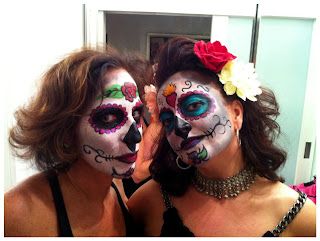Throughout the years, people continue to mistake el Dia de los Muertos for Halloween. Since Day of the Dead decorations include calaveras (sugar skulls) and skeletons, people often believe it is the holiday, in Mexico, where children also go door-to-door for sweets and candy. However, Day of the Dead is a holiday during which families build and decorate altares (altars) in honor of the dead. Families also visit the cemetery to decorate the graves of the dead. Preparation for Day of the Dead may take a few weeks, but families believe in taking time to remember and honor the dead. After the food is cooked, the candles are lit, the graves are decorated, and the altars are completed, families are prepared for the arrival of the spirits on November 1st and 2nd.
All Face and Mask paint done by Mia Roman Hernandez
The Beginning: Aztec Customs Join the Catholic Church
In the 1500's, Spaniards arrived in Mexico and brought along their Christian beliefs and traditions. They “viewed death as the end of life,” while the Aztecs believed that "life was a dream and only in death did they become truly awake" (Miller). The Aztecs believed in honoring the dead, through a month long ritual "during the Aztec month of Miccailhuitontli" (Salvador). Because the Spaniards wanted to convert the Aztecs to Catholicism, they tried to abolish the rituals dedicated to the dead. Spanish priests abhorred that the Aztecs celebrated the dead during a non-Christian celebration. However, attempts to abolish the Aztecs’ festivities and traditions failed, so "the Spaniards moved [the Aztecs’ rituals] so that [they] coincided with All Saints’ Day and All Souls’ Day (Nov. 1 and 2)” (Miller). Spanish priests, therefore, attempted to blend the Aztecs’ customs with Catholic Christianity. All Saints’ Day became a time to celebrate and “honor the saints of the Catholic Church,” while All Souls’ Day was a “time to pray for the souls of the departed” (Hoyt-Goldsmith 12). Despite the Spaniards attempts to eradicate the Aztecs’ customs by linking their rituals with Catholic holidays, the celebrations continue to focus on remembering and honoring the spirits of the dead.
El Dia de los Muertos (Day of the Dead) is and will continue to be an important part of Latina American families. Despite the changes the celebration has incurred, it transmits generation after generation the belief that death is not the end of life. Individuals should feel comfort in knowing that after they die, their family members will celebrate a holiday in which the dead are remembered and honored. Rather than view death with fear, people should embrace death and believe the Aztecs who said "only in death did they become truly awake" (Miller). Only after death will individuals be capable of resting in peace and truly living.




No comments:
Post a Comment